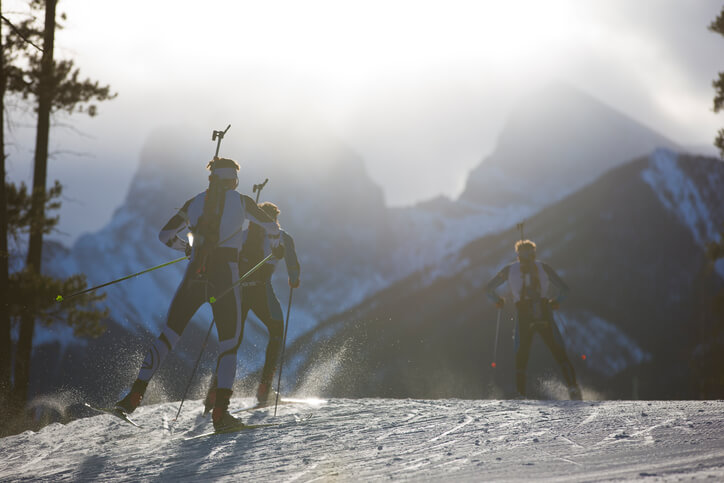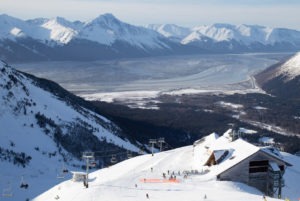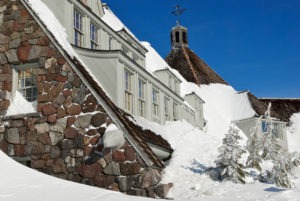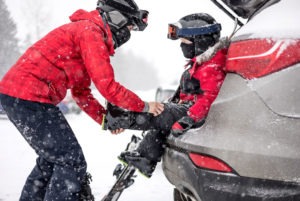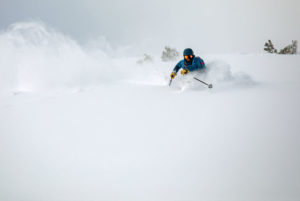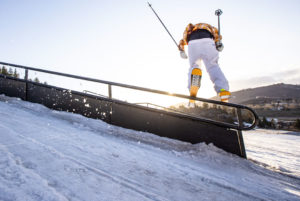The 2018 Winter Olympics are around the corner. Time to wax those skis, sharpen the skates, slip into those cross country ski pants, and load the guns. Looking more like a James Bond movie, the Biathlon is arguably one of the coolest, yet least known, events at the Winter Olympics, combining the endurance of cross-country skiing with the skill of an expert marksman.
What is Biathlon?
In principle, it is quite similar to other Olympic events that end with “athlon” (triathlon or pentathlon for example). You have to be good at a bunch of different stuff. For instance, in a triathlon, it’s swimming, cycling, and running. In a biathlon, you only have two things to do: cross-country ski and shoot a gun.
If the whole thing sounds like fun, you are not mistaken. Biathlon is hugely popular out in Europe, where it originated. And it can be a lot of fun to watch on TV, with missed shots and nail-biting finishes. Imagine cross-country skiing for miles, racing uphills and across open fields with a rifle slung across your back.
Imagine cross-country skiing for miles, racing uphills and across open fields with a rifle slung across your back. Then being tested throughout your race on your shooting accuracy. Remember: you need steady hands, controlled breathing, and focused mind to hit your target. Each missed shot carries a penalty, either in the extra distance or in added time to your score. Whatever it may be, a walk in the park it is not. Cross-country skiing is an incredibly demanding sport on its own. And biathlon just takes things to the next level.
Much like different variations of a road race or sprint, the biathlon also has various events based on the same basic concept. You have the long distance individual races, the shorter sprints, pursuits, and relays. The broad rules are identical for every event: you have to ski for a set distance, and in between, you have to get five shots on target. The shooting is done with a small-bore rifle, and half the shooting rounds are in the standing position while the other half is in the prone position. The contestant with the shortest time, in the end, is the winner.
History of Biathlon
Biathlon is truly a sport for badasses. So it comes as no surprise that it arose in the land of people well known for their badassery: Vikings. That’s right, the origins of biathlon lie in Scandinavia in northern Europe. The folks there have always been big on skiing, well they had to be, their land was covered in snow for the most part.
Since hunting on skis was a basic survival skill in winters, these cultures evolved traditions and gods for these activities. Norse deities like the goddess Skadi and the male god Ullr were both patrons of hunting (archery) and skiing. So, traditions in honor of these Old Gods involved activities that combined both activities. And in the era of guns, this tradition became part of military training in countries like Norway starting in the 1700s. A civilian version of the sport soon followed, which evolved into the modern sport of Biathlon.
Biathlon first became an event in the 1924 Winter Olympics, held at Chamonix, France. The event was then called “Military Patrol,” a name that harkens back to its military roots. It was a team event, involving three skiers. Incidentally, the Scandinavians did not win this event then. That honor went to the Swiss, who finished first ahead of five other teams. But the sport was plagued by a lack of standardized rules, so it did not become a fixed event until after World War II.
Modern Biathlon owes its popularity to two countries: The Soviet Union and Sweden. Both countries introduced the event into their popular winter games calendar in the 1950s. The sport rapidly gained in popularity, and a World Championships (1958) was soon followed by inclusion in the Winter Olympics in 1960. The womens Biathlon event was added in 1992 during the Albertville Olympics in France.
Biathlon Rules
There are five different biathlon events at Winter Olympics: individual, sprint, pursuit, relay, and mass start. They all have the following basic rules:
- The sport is all about completing the race in the shortest possible time.
- In between the cross-country skiing sections, biathletes have to use their rifles in several rounds of target shooting.
- The targets are usually 50 meters, or 160 feet away. They are made of black/metal circles on a white background. The targets flip to white when they are hit.
- At different stages of the race, they have to shoot from various positions, either standing or prone.
- In standing position, the targets are wider, at 4.5 inches. During the prone stages, the targets are narrower, at around 1.8 inches.
- Missed shots are severely penalized, with either time added or distance penalties. These penalties can add up quickly, so the sport places a heavy emphasis on control and accuracy while under physical duress.
- For a biathlete to complete the race, he/she has to hit the target five times in each round successfully. They cannot leave the shooting stage until all the targets have been hit.
Biathlon Equipment
Skis, Poles, Boots & Suits
Since the skiing part is basically cross-country skiing, biathletes use the same equipment used in that sport. This means those skinny Lycra suits, gloves, hats, and tinted sunglasses when necessary. The preferred skiing technique used for a Biathlon is freestyle, so the skis are shorter and stiffer, with less curve at the tips. The poles are also longer and stiffer, as they are for freestyle cross-country.
Looking for a new pair of cross-country skis? Shop our selection!
Biathlon Rifles
In the early era of Military Patrols, they used high-powered army rifles, like the ones with .30-06 Springfield cartridges. In 1978, the powers that be decided to switch to .22 rimfire caliber, which is the most popular variant used for recreational shooting. You cannot use semi-automatic or automatic rifles in biathlon. And they don’t allow any optics, or fancy laser sights either on a biathlon rifle. So you are left with simple bolt-action rifles, with iron sights, and a minimum weight of 7.7lbs. The magazine of the biathlon rifle should have a maximum capacity of 5 rounds only.
Despite their threadbare specifications, the modern biathlon rifle features a lot of innovative design and engineering. The guns have been optimized for both standing and prone positions. Since they have to be carried on your back during the skiing section, they come with special slings, muzzle covers, and harnesses/backpacks. Straight pull actions and integrated magazine carriers on the rifle stock ensure that athletes can quickly load the rifle and get into firing position. Special repeater devices ensure that shooters don’t have to take their hand off the rifle grip to reload the gun after each shot.
Biathlon Techniques
Cross-Country Skiing
In regular cross-country skiing there are two main techniques: classic and skate. Although you can use both forms of skiing in a Biathlon, most athletes use the more aggressive skate style, also called freestyle technique. This technique is similar to ice skating and requires more skill, stamina, and full-body coordination. Biathlon skis are only bound to your foot at the toes, allowing you to flex and move your feet around for better control while skiing. Ski poles are also essential, especially for the grueling uphill sections.
Shooting
To really get a good shot at a target, the goal is to try and relax your body and mind. This is almost impossible to pull off when you have just completed 2-3 miles of cross-country skiing and can hear competitors shooting and the crowd cheering. Heightened heartbeats, and faster breathing work against you. When a biathlete approaches the shooting section, their heart rates are often in the 160-180 beats per minute range. You simply cannot get your body to relax in time in these situations fully.
So what they do is to gently ease their body by slowing down as they approach the shooting section. The aim is to get the body as relaxed as possible and the mind focused. And unlike in regular target shooting, biathletes train to shoot while under physical duress. A standard technique is to learn to shoot just before the exhalation part when the body is relatively still.
Preparation is also critical. Coaches and athletes often scout the course before the race to fire a few practice shots and get firsthand knowledge of the race conditions. During the race, coaches also relay information regarding their race position and times to the racers, using hand signals.
Biathlon Events at The 2018 Winter Olympics
There will be eleven biathlon events at the PyeongChang Winter Olympic Games, to be held between February 10-23. There are gold, silver and bronze medals for the top three finishers in all these events. They are:
Individual Race: 20Km Mens, 15Km Women’s
This was the original variant of the sport. It is also the longest race in Olympic biathlon. This event has four different shooting stages in between, and the biathlete must hit all five targets in each stage. Missed shots are given a one minute time penalty.
Sprint Race: 10Km Men’s, 7.5Km Women’s
This race is only half the length of the standard Individual race. It is usually held on a three-lap ski race course. And the number of shooting stages is also reduced to two. Each shooting stage has five targets. For each missed shot athletes are required to race through 150m penalty loop for each missed shot.
Pursuit Race: 12.5Km Men’s, 10Km Women’s
This event is only open to the top 60 qualifiers from the sprint race. This is basically a game of “catch up” played across five laps, with four shooting sections. The first racer is the biathlete with the best time in the sprint event. Other competitors follow him/her in the order of their finishing position in the sprint race tables. The first racer to cross the finish line wins.
Since the shooting event takes time, they act as the equalizers in this event. Players can get queued up at these sections. With a “first come first serve” system, every skier has to wait for his or her turn to shoot. And if the leaders miss their shots, the pursuers get a chance to close the gap. Missed shots are penalized with one lap through a 150m penalty loop.
Relay Race: 4×7.5Km Mens’, 4x6Km Women’s
This is the biathlon equivalent of the 4x100m track and field sprint relay. Each team member has to finish a three-lap course, with two shooting rounds each. As usual, there are five targets in each shooting round.
For the first three misses in each round of a relay race, you can manually reload the bullet and try again. But if you miss again, a lap in the 150m penalty section beckons. As in a traditional relay, all the competitors begin the first lap simultaneously. And after completing their section, they have to touch their teammates to “pass the baton.”
Mass Start: 15Km Men’s, 12.5Km Women’s
This is the newest variant of the Biathlon to feature at the Winter Olympics. It was only added in the 2006 Olympics in Turin, Italy. The mass start contestants are selected from the pool of participants who finished all the other races. The top 30 contenders are picked, based on their cumulated scores. This is a 15 Km long race for men, and 12.6 Km for women.
As the name suggests, all the racers start the event together. The beginning looks a bit like the beginning of a marathon in the Summer Olympics. There are five laps, and four shooting rounds in between those laps. Missed targets result in a 150m lap through the penalty loop.
Mixed Relay
This is another new concept, where two female participants race in the first two runs, followed by two male participants. The rules for the race are taken from the regular relays.
The Olympic Venue for Biathlon Events
The venue for all Biathlon events at the 2018 Olympics will be the Alpensia Biathlon Center, which is located in the PyeongChang Mountain Cluster. This is the same venue where other Nordic events like cross-country skiing and ski jumping will take place. Other notable events to be hosted in this center include luge, skeleton, and bobsled.
Biathletes to Watch at this Years Olympics
Men
Ole Einar Bjorndalen (Norway): Veteran of 6 Olympics, starting with 1994, and winner of 8 Olympic Golds, nicknamed “The King.”
Dominik Landertinger (Austria): Silver Medalist in 10Km Sprint, and Bronze at Men’s Relay in Sochi Olympics 2014.
Lowell Bailey (USA): the first ever Biathlon World Champion from the US, seeking his country’s first medal in this event.
Martin Fourcade (France): Superstar with 11 World Championships, with 4 Olympic medals, including two golds in Sochi
Anton Shipulin (Russia): Winner of Gold in the Men’s Relay at Sochi, 4th position in 10Km Sprint in Sochi
Women
Laura Dahlmeier (Germany): 13 World Championship medals between 2014-2017, with seven golds, five of them at the 2017 event.
Tiril Eckhoff (Norway): Twin gold medals at the 2016 and 2017 World Championships, Won two bronze and one gold for relay events in Sochi 2014
Darya Domracheva (Belarus): Triple gold medalist at Sochi 2014, Bronze in Vancouver 2010, Runner-up at 10Km pursuit in World Championships 2017
Susan Dunklee (USA): Won the first ever women’s World Championship medal for the USA at 2017 World Championships, also a veteran of Sochi Olympics
Marie Dorin Habert (France): Five-time world champion, with two Olympic medals in the 2010 Olympics
Love the world of skiing but not sure where to start? Check out our cross-country ski gear for beginners.
